Fluke FLUKE-381, Remote Disp 1000A Trms Clamp W/Iflex
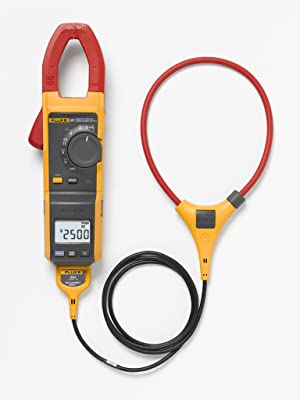

Flexibility in your Hands, detach, clamp, or probe.
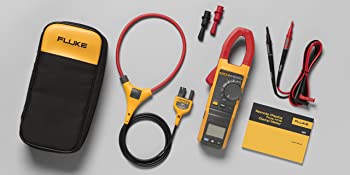
Included in the box
What to expect in the box?
- 45 cm iFlex current probe
- Coated instruction card
- Safety information sheet
- Soft carrying case
- TL75 test leads
- 5x AA Alkaline batteries
Fluke 381- Remote Display True RMS AC/DC Clamp Meter with iFlex
The first clamp meter with a detachable, remote display and iFlex probe for easier, faster, safer measurements.
Fluke 381 is not just a clamp meter it does everything you would expect from a clamp meter with added features makes troubleshooting more straightforward. Now one technician can do jobs that used to require two people; clamp the Fluke 381 around a conductor, remove the display and walk across the room to operate controls or remove protective equipment, all while watching real-time readings.
- Up to 25000 A AC with the iFlex current probe
- AC/DC range up to 1000 V
- 60 kΩ resistance measurement with continuity detection
- Intergrated low pass filter
- CAT IV 600V, CAT III 1000V safety rating
- Backlight display
| | |
|
|---|---|---|
iFlexThe Flexible current probe expands the measurement range to 2500 A ac while providing increased display flexibility, ability to measure awkward sized conductors and improved wire access. | Detachable displayWireless technology allows the display to be carried up to 30 ft/ 9 m away from the point of measurement for added flexibility without interference with measurement accuracy. | |
| Dimensions: | 27.69 x 4.32 x 8.64 cm; 453.59 Grams |
| Model: | FLUKE-381 |
| Batteries Included: | 5 AA batteries required. (included) |
| Manufacture: | Fluke |
| Origin: | Germany |
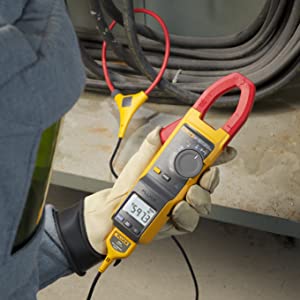
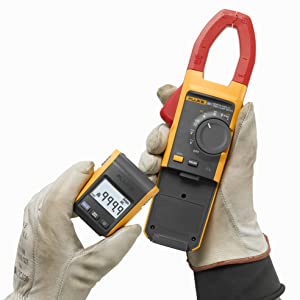
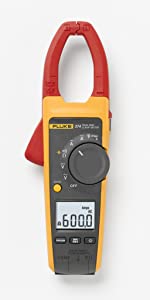

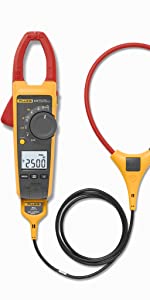
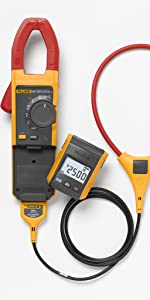
This is a great product. I love the iFlex amp clamp. It helps when you need to clamp 4 or 6 500 or 750 MCM wires. I love the wireless display much better than the other one with the Bluetooth fluke connect option.
Great meter for trouble shooting the detachable face really come in handy when in tight spaces
Aber fr 650 Knnte man schon erwarten, das man auch das drehfeld berprfen knnte.
Hallo ihr lieben wieder was Neues von Fluke habe schon mehrere Stromzangen von Fluke aber nach lngeren berlegen habe ich mir die Fluke 381 Stromzange bestellt warum nun ich arbeite an Autos wo die Stromzange am Verbraucher angeschlossen ist und ich wo anders am Fahrzeug arbeiten musste und ich jetzt das Display jetzt ich direkt bei mir habe und ich dadurch die Werte sofort ablesen kann !
So ist es jetzt eine enorme Arbeits Erleichterung da ich jetzt keinen 2 Mann mehr brauche die Messeleitungen und Abgreif Klemmen habe ich verschenkt und mir von Fluke ordentliches Werkzeug zugelegt sprich Messeleitungen Abgreifklemmen lang und Kurtz die ich auch bei allen meinen anderen Fluke Messgerten besorgt habe !
Die Flexible Strom Zange ist eine Beigabe die nicht brauche da ich meistens an DC Bereich arbeite was den Preis natrlich hochtreibt aber diese Stromzange gibt es nicht anders zu haben die Schutz Tasche knnte ein wenig grsser sein fr die Zange und Zubehr aber es geht auch so !
Nicest meter I’ve owned. Everything I need in a meter and then some.
It more than exceeds great investment and time saver.P Turne
The leads that come with this are fantastic; soft and flexible, they have no tendency to kink or bend and always roll up or unravel smooth and free-flowing. Incredibly well thought out, read the details on them they have a lot of cool features. The alligator clips are pretty handy too.
The wireless display is really great, sometimes saves you from borrowing another set of hands or from running back and forth. Range is good enough to make me feel like it was worth buying, more would be useful at times.
I bring it home occasionally to use on house or vehicle wiring and really appreciate the wireless screen.
I purchase the Fluke 381 clamp to illustrate inrush amperage, compared to just amperage in our electrical training. The fact that the display is removable is great.
I have already done significant troubleshooting with this meter. The large loop is nice for very tight spots, but it works AC only. For DC or AC you will need to use the attached clamp. Remote readout (detachable) is very convenient when working on my truck or other vehicles. It is a battery hog!
Second purchase for a customer ! The Department Mgr loved the first one and wanted another.
The detachable display works well and is easy to detach. The flexible coil is a great feature and absolutely needed to measure many compact or tight panels.
I put off buying this for years due to the cost. But I wish I bought it a long time ago. The first time I used it I was using the DC Amps scale on the brake signal wire under the dash while I had the remote display under the hood moving wires to find a short to ground.
The 381 can measure voltage to 1KV on AC and DC systems, and of course has resistance measurements and includes a continuity buzzer. Now this does lack the diagnostic features of an electronics meter but that’s to be expected. This is an industrial amp meter. The jaw clamp will take AC and DC current measurements to 999.9A in 0.1A increments. The iFlex clamp will take AC measurements to 2500A in whole numbers but will not take DC current measurements. Unlike other external clamps this uses a proprietary 3 pin connection to connect to the iFlex thus yielding accurate and appropriately quantified measurements. Now bear in mind clamp designs due to their nature of measuring magnetic fields inherently have a margin of error and this one if memory serves is between 2% and 5% depending on the range and frequency of power. Cabling should placed in the center of the jaws or the flex clamp to obtain best accuracy. Of course the meter can be “hung” on the cabling if accuracy is less of a concern and/or additional safety measures are needed. For those who have never used a clamp meter, measurements are taken by clamping onto an individual conductor in a circuit. The equipment ground conductor, the neutral conductor, and any additional hot conductors need be outside the jaws as these conductors will cancel out the readings taken. In other words placing a cord inside the jaws will yield a amperage reading of 0. The conductors need to be separated to obtain measurements. Hence the industrial nature of this meter and most clamp on meters.
Note: I strongly discourage the homeowner tendency to split open an extension cord to obtain these measurements from a load with a traditional plug. For these types of measurements there are commercial plug-in adaptors available like the Amprobe ELS2A or the Extech 480172. In commercial / professional settings, typical measurements are taken off the loose conductors in j-boxes and the like. Again this is something I recommend extreme caution in practice and advise the inexperienced to avoid trying. Electricity is dangerous even if you know what you’re doing and is deadly if you don’t.
Onto the real review…
What I love –
I mentioned above this clamp meter will take amperage measurements (in the clamp jaws) of both AC and DC systems. For my usage, the DC side can be quite indispensable and not all clamp meters work on DC installations. But then not all users need DC current measurement capability either. Next the 381 features a low pass filter to eliminate errors in voltage measurements due to harmonics in an AC system. Where this becomes apparent is when working on large non-linear loads such as VFDs or even large AC to DC converters. Unlike other meters such as the 87V, this feature is not switchable and instead is always enabled. However in electrical work this shouldn’t pose a problem. It could limit the 381’s usability in electronics diagnostics but again this is not an electronics meter. The next excellent feature is the “inrush” [current] measurement which I love. With this measurement the meter is placed on a hot conductor in the circuit. A load is then switched on and the 381 measures the peak amperage for the first few dozen cycles (for about 100ms I believe.) This gives a reading of the “inrush” or “startup” current which can be many times higher than the running current. This is one of features that sets the Fluke 370/380 series of clamp meters above the competition. The iFlex is of course another of these “cut above” features. The jaw clamp has an internal opening of …. The iFlex is much larger with a diameter of…. The iFlex can also be squeezed into compartments where traditional jaws may not fit or routed through and around other conductors if need be. There may be a penalty in accuracy but that’s a small trade off for obtaining a measurement that otherwise couldn’t be obtained. I love that the iFlex has its own setting on the main dial and that thanks to its 3 pin connector, gives a readout in amps and without any need for “multiples of this or that mathematics.” On this meter, with the external probe, an amp is an amp and it’s as simple as that. The last trick the 381 has up its sleeve is the remote display. The user can unlock the display and carry it to a better position up to 30 ft (or so the literature says.) I’ve had mine to about 20′ with no issues. This meter uses some form of GSM wireless communication when undocked from the main body. When docked with the main body the display appears to use an IR window to receive signals I’m not sure if there is two-way communication or not. The display has three buttons on it including “hold”, “min/max”, and the backlight. Min/Max info could be handled onboard I suppose. But if I had to guess I’d say communication is bi-directional. I remember reading that “other displays can be synchronized” to the body but that only one display can be synced at a time. The question I have, to which I don’t yet have an answer is whether two or more 381s can be used in wireless mode at the same time. I’m not sure if there would be interference or cross talk but it’s not really something I need, just more of a curiosity. The other controls on the main body are the “zero” and “inrush” buttons as well as the mode selector dial. Back to the remote display, in addition to its wireless communication Fluke decided to give us one more handy feature. The back of the display has a magnet so this can be placed where its most easily viewed or to let the technician use the probes or to control the load being tested. Lastly I applaud Fluke for giving the consumer two things that should be standard equipment with all of their meters but aren’t. The first is a soft side case for the meter and accessories. The second is a set of their genuine silicone rubber test leads. They include a pair of TL175 which have a twist lock safety shroud for the probe tips. Twist the end of the lead and the shroud extends or retracts. This is a safety feature for working on CATIII and CATIV installations. But for me the real safety feature is the silicone rubber leads themselves. In other meters I’ve purchased from Fluke, I’ve received their TL75s which are garbage in my opinion. Safety-wise they carry excellent ratings but the cheap plastic jackets over the wire, kink and get tangled. This can quickly become a safety concern if you have to fight a kink causing you to lose concentration on what you’re working on. Flukes silicone rubber leads like the TL71, TL175, and the models in the TL220 series have no memory and even after months wrapped with a twist tie fall straight and free when unwound. Thumbs up Fluke!
What I like –
I like this meter’s resolution. It yields a 0.1V to 600V resolution which is much better than other clamp meters that are only accurate to the volt then 600V to 1000V in wholes numbers. I won’t go into accuracy & counts vs. resolution but can say that resolution does play a part in the inherent accuracy of a meter. That extra 1/10 scale means a lot to someone like me who is interested in obtaining the most accurate reading possible. Next I like the backlight. This isn’t something found always on a clamp meter and its indispensable in my opinion. In my experience, electrical problems always seem to hide in poorly lit areas. The “zero” key is important as it lets the user zero a measurement even if the line has a small amount of current on it. It can also be used to zero prior to a reading to see change in current as opposed to total current flowing on a line. I like the “feel” of the 381. The dial is a tad stiff but is well placed and could be used one handed. The thumb “trigger” on the jaw clamp is well placed and easy to operate. The display is pretty large for this class of meter and is easy enough to read. The probe inserts are on the bottom which means the meter (with the iFlex attached) can fit into narrow spaces and is a bit less bulky. This is a bit of a trade off though as probes with 90 banana plugs (90% of probes out there) feel a bit awkward on the bottom of this meter.
Room for improvement –
There really isn’t much not to like here but I’ll list a few negative impressions in the spirit of being objective. First is the inherent flaw nearly all amp clamps suffer. The case. Unlike a traditional multimeter these almost never have a protective rubber boot/holster. Which means when gravity pulls your meter back to Earth (and usually, to concrete) the chance of damage to the casing and the internals is much greater. The 381 has an Achilles heel here as well. That lovely remote display will almost certainly go flying after impact and in the case of a face first impact will hit first as it sticks out about ” from the main body. There’s always a downside to a cool feature, and this is the 381’s. Next is the lack of a Low-Z (aka a low impedance) voltage measurement. Being an industrial meter I feel this would’ve been a great feature to include for eliminating ghost voltages. You can buy an adaptor (Fluke’s SV225) but I feel this is something that should come with this class of instrument to begin with. Finally is the “hold” feature. Fluke has their patented “touch hold” which operates by waiting for the probes to touch a circuit and records that (much the same as inrush feature works on this meter.) However Fluke gave us instead a “display hold” which once pressed the reading on the screen is frozen. Honestly I’ve seldom found display hold to be of much use. But in fairness touch hold may have been too complex to implement given it would have to talk two ways in real time with the remote display.
In the box you get:
-Fluke 381 meter w/ remote display
-Fluke iFlex external flex clamp
-A pair of TL175 silicone leads
-A pair of AC175 over the probe alligator clips
-A Fluke soft case for the meter and accessories
Final thoughts… The 381 is Fluke’s current top of the line industrial clamp meter and reflects that with its ballpark $400-425 price tag. For those seriously looking at this meter I doubt I’ve told you anything you didn’t already know. But for those just beginning their search for a clamp meter, this is a good example of what a top of the line model looks like. Is it over kill for a home owner meter? Probably. But it does have a set of unique features that make it attractive to professionals and hobbyists alike. All I can say is my need for an accurate AC and DC clamp meter lead me to this unit. The other features, especially the remote display I have found handy but weren’t integral to my application either. Truthfully like all professional meters, it really is for you to decide whether it’s worth it to you or not. Personally I would buy again, as I really like the 381. However I wouldn’t rule out purchasing the 376 either. The 376 spec wise is nearly identical to the 381 except it lacks the remote display. All other features including AC/DC functionality, inrush current measurements, and iFlex attachments are still intact. And this meter clocks in around $80-100 cheaper. All in all I’m quite satisfied with the 381 and it’s filled the hole in my instrumentation that only a clamp meter can satisfy. As such I give a glowing endorsement to any perspective users who have need of this feature set, find the functionality appealing, and aren’t turned off by its price.
I don’t know how to use it and anything about the functions because it’s for my daddy.
Great Product!, No Complaints, All Good, Delivered On Time, Nice Quality, Would Purchase Again, Would Recommend to Others, Money well spe
Love fluke, and after using this i still love them, easy to get started and get moving. easy to understand, simple but powerfull tool
I have avoided Fluke products for years due to the cost in comparison to other electronic meters. But much to my amazement, I now understand the reason for the cost. Very robust, accurate and easy to use.
I needed a meter which would perform measurements on high level DC current and this meter hit the spot.
Regards,
L
Highly recommend!
This meter is awesome!!! I Like the Hertz functionality when using VFDs…. The I-Flex is great for those tight spots, although I haven’t had the need to measure 2500 or even 500 Amps at that. Never hurts to be prepared. Also the leads and alligator clips that come with it are real nice.
Five Stars For this one.
It is my opinion, that every electrician & contractor has this meter as part of their test equipment arsenal. I have used it on AC & DC circuits, and it is very accurate. Having the remote display makes it more convenient being able to place it in an optimal position for viewing.
of removable display, where you place the measuring device and the display can
keep up with the departure of one or mot, ocilao energy while commanding the
drives, not to mention in your presentation in front of your customer.
thanks.